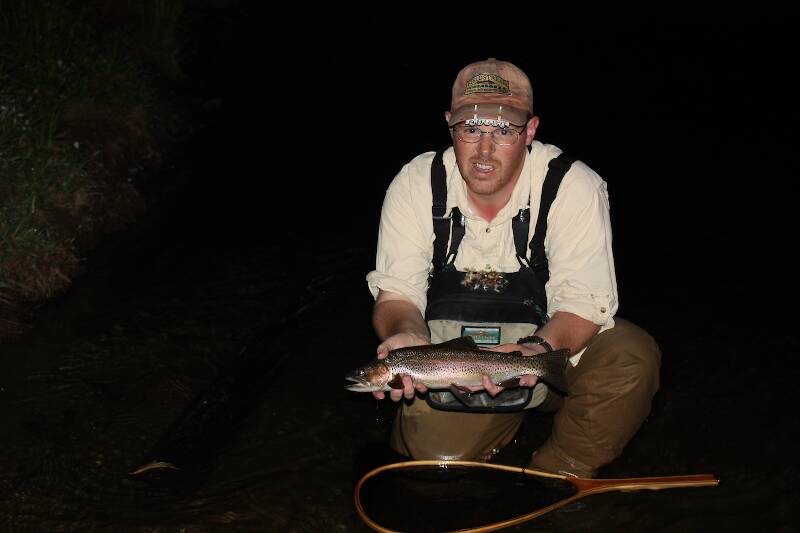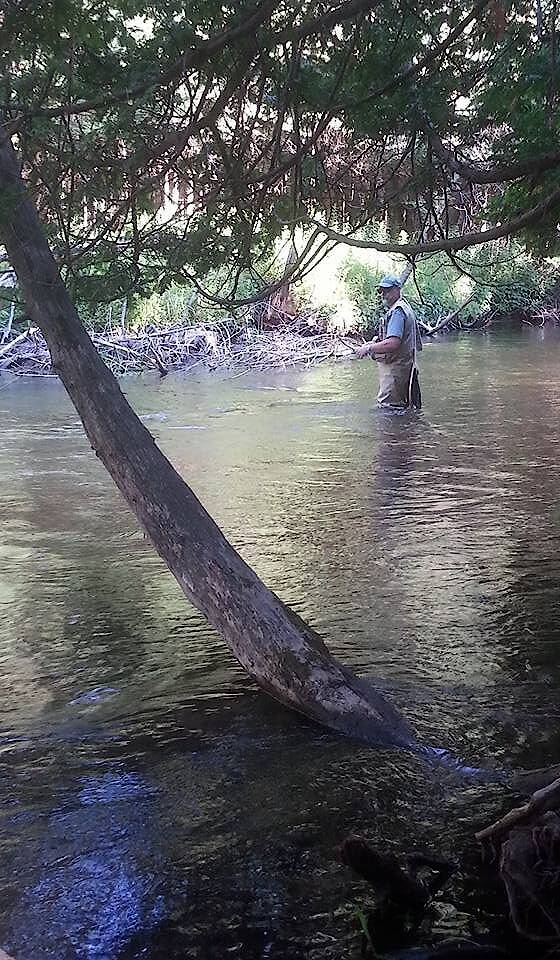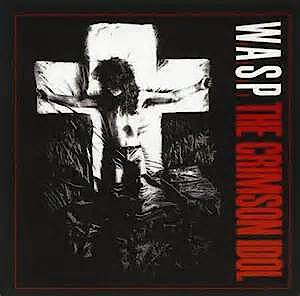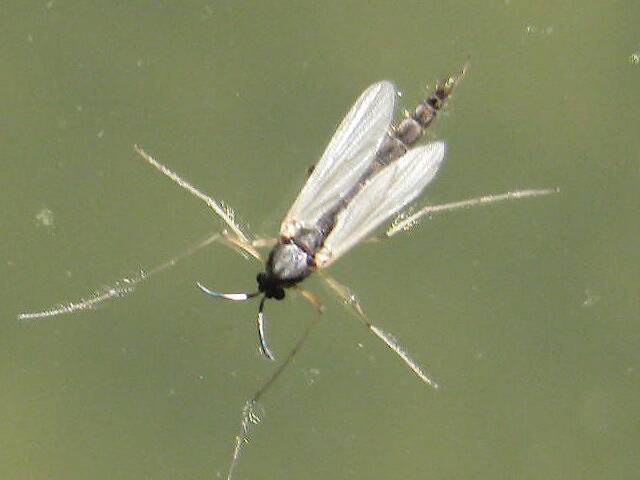
Blue-winged Olives
Baetis
Tiny Baetis mayflies are perhaps the most commonly encountered and imitated by anglers on all American trout streams due to their great abundance, widespread distribution, and trout-friendly emergence habits.
Featured on the forum

This wild-looking little thing completely puzzled me. At first I was thinking beetle or month larva, until I got a look at the pictures on the computer screen. I made a couple of incorrect guesses before entomologist Greg Courtney pointed me in the right direction with Psychodidae. He suggested a possible genus of Thornburghiella, but could not rule out some other members of the tribe Pericomini.

Troutnut is a project started in 2003 by salmonid ecologist Jason "Troutnut" Neuswanger to help anglers and
fly tyers unabashedly embrace the entomological side of the sport. Learn more about Troutnut or
support the project for an enhanced experience here.
Troutster
Posts: 4
Posts: 4
Troutster on May 13, 2008May 13th, 2008, 7:36 am EDT
I'm a long time reader, first time poster. I live in south central PA and have fallin' in love with fly fishing recently, I've only caught one trout on the fly rod (I'm a converted spin fisherman from way back) but I'm pretty sure it's just a matter of time till I get the hang of it.
I have a burning question that I can't seem to find the answer to anywhere, I'm hoping you guys can help. Can you use regular old mono line (trilene, stren, etc) to build effective/quality leaders. It seems that it would be more cost effective to use regular old mono than mono designated as leader material. Any asnwers would be greatly appreciated.
I have a burning question that I can't seem to find the answer to anywhere, I'm hoping you guys can help. Can you use regular old mono line (trilene, stren, etc) to build effective/quality leaders. It seems that it would be more cost effective to use regular old mono than mono designated as leader material. Any asnwers would be greatly appreciated.
Taxon on May 13, 2008May 13th, 2008, 8:28 am EDT
Troutster-
Fly fishing leaders need to be tapered in order to properly turn the fly over, particularly when dry fly fishing. Manufactured fly leaders are smoothly tapered in the production process. However many fly fishers build their own tapered leaders by knotting together short lengths of successively smaller diameter mono. These are called "knotted" leaders, and many formulas exist for the respective diameters and lengths.
Fly fishing leaders need to be tapered in order to properly turn the fly over, particularly when dry fly fishing. Manufactured fly leaders are smoothly tapered in the production process. However many fly fishers build their own tapered leaders by knotting together short lengths of successively smaller diameter mono. These are called "knotted" leaders, and many formulas exist for the respective diameters and lengths.
Troutster
Posts: 4
Posts: 4
Troutster on May 13, 2008May 13th, 2008, 8:49 am EDT
Sorry I should have been more specific, I know they need to be tapered, I meant to use regular mono tapered just like you would use maxima ar whatever.
LittleJ on May 13, 2008May 13th, 2008, 3:28 pm EDT
yes you can, and in fact i use yellow stren as a strike indicator on my leaders. The trick is finding the right diameter line. the following is a basic formula for a standard george harvey 5x leader.
10"-.017, 20"-.015,20"-.013,20".011,12"-.009,10"-.007,28"-.006. I use maxima (or whatever you can find in the correct diameter)up to .009 and a soft tippet for the rest.
jeff
10"-.017, 20"-.015,20"-.013,20".011,12"-.009,10"-.007,28"-.006. I use maxima (or whatever you can find in the correct diameter)up to .009 and a soft tippet for the rest.
jeff
Troutster
Posts: 4
Posts: 4
Troutster on May 14, 2008May 14th, 2008, 12:39 am EDT
LittleJ
thanks for the answer, how do you use the yellow stren as a strike indicator, that sounds like something that I could really use.
thanks for the answer, how do you use the yellow stren as a strike indicator, that sounds like something that I could really use.
LittleJ on May 15, 2008May 15th, 2008, 7:34 am EDT
It use it for short line nymphing. I build my leaders w/ yellow stren and red & green amnesia(not the running line) in the butt sections. The yellow stren I use is .013 and I use 10" of stren and 10" of maxima to make up the 20" .013 section per the harvey formula. The main reason i use different colors is so I know roughly what depth i'm fishing. I also add a very small dab of bio strike further up the leader so should the need arise I can long line nymph as well. Hope this helps.
Jeff
Jeff
JOHNW on May 15, 2008May 15th, 2008, 4:22 pm EDT
Troutster,
Another option for building strike indicators into your leader is to take a contrasting color of permanent marker and put one inch bars down the leader. The real trick is creating points of contrast for your eye to pick up.
JW
P.S. Where in South Central PA are you?
Another option for building strike indicators into your leader is to take a contrasting color of permanent marker and put one inch bars down the leader. The real trick is creating points of contrast for your eye to pick up.
JW
P.S. Where in South Central PA are you?
"old habits are hard to kill once you have gray in your beard" -Old Red Barn
Martinlf on May 16, 2008May 16th, 2008, 12:56 am EDT
Or just use small dots of Orvis Strike Putty. A little dab will do ya. I typically use two to three tiny bits rolled on several feet apart where I think I'll need to be looking.
"He spread them a yard and a half. 'And every one that got away is this big.'"
--Fred Chappell
--Fred Chappell
Troutster
Posts: 4
Posts: 4
Troutster on May 16, 2008May 16th, 2008, 1:08 am EDT
Thanks guys for all of the suggestions, if you put marks on the leader with marker would the trout be able to notice it on clear spring creeks (I'll be fishing the Falling Springs).
JohnW, I'm also from Chambersburg.... could they be doing any more bridge work on I-81!!
Do you fish the Falling Springs much, I fished it for the first time last Saturday, what a beautiful stream , even thought I didn't catch any but I plan to keep trying.
JohnW, I'm also from Chambersburg.... could they be doing any more bridge work on I-81!!
Do you fish the Falling Springs much, I fished it for the first time last Saturday, what a beautiful stream , even thought I didn't catch any but I plan to keep trying.
JOHNW on May 18, 2008May 18th, 2008, 5:36 am EDT
Troutster,
I porbably wasn't as clear as I could have been. When using the marked leader technique it is only on the butt and taper sections. the tippet is left as is. This is more frequently because I frequently switch from nymph to dry without changing the entire leader.
Will the trout be more apt to see the barring? I guess they might however not any more so than any other form of strike indicator and probably significantly less than most.
I think you will find most trout generally more approachable than some would have you believe. I seldom crawl up to the stream but I do move very slowly and pay close attention to the sun as a shadow will send fish scurrying as quickly as chucking a rock in the stream next to them.
As for Falling Springs in general it is a wonderful little stream decent hatches, fair populations of wild fish in the upper waters and easy access. The only drawback is it flows through a very residential area and as such you are frequently fishing in peoples back yards.
JW
I porbably wasn't as clear as I could have been. When using the marked leader technique it is only on the butt and taper sections. the tippet is left as is. This is more frequently because I frequently switch from nymph to dry without changing the entire leader.
Will the trout be more apt to see the barring? I guess they might however not any more so than any other form of strike indicator and probably significantly less than most.
I think you will find most trout generally more approachable than some would have you believe. I seldom crawl up to the stream but I do move very slowly and pay close attention to the sun as a shadow will send fish scurrying as quickly as chucking a rock in the stream next to them.
As for Falling Springs in general it is a wonderful little stream decent hatches, fair populations of wild fish in the upper waters and easy access. The only drawback is it flows through a very residential area and as such you are frequently fishing in peoples back yards.
JW
"old habits are hard to kill once you have gray in your beard" -Old Red Barn
Roguerat on Aug 5, 2011August 5th, 2011, 8:05 am EDT
i've used so-called 'level leaders' for N Pike- and only Pike. 6-8' of 12 or 14 lb test mono with a 12" wire bite-tippet attached via an Albright knot, Wire is just a simple store-bought leader complete with the duolock snap to make fly (read that BIG fly) changes easier.
Sayfu
Posts: 560
Posts: 560
Sayfu on Aug 14, 2011August 14th, 2011, 5:07 pm EDT
There are lots of options for leaders..I tie my own knotted, tapered leaders, and then buy tippet material for the tippet end which is mono also it is just good, accurate sized mono. But here is a suggestion. Start with a 9' tapered leader. When you use up the tippet, and it gets down to say 16', take out some new tippet material, cut the tippet back to 4-5" and add several feet of new tippet with a blood knot. When you use up that tippet, and tie on a new tippet, you may find that the diameter of the leader you are tying the tippet to is rather large, and need to tie a new 10" section of a piece of mono several thousandths bigger than the tippet you are using. By knotting on new tippet you've used up some of the taper up stream from the tippet. Now you have several knots in your leader end making up a new tapered leader. My point is..you can start with an unknotted, tapered leader, and end up with a rebuilt leader with several knots in it. I can go through an entire season starting with one leader. KEY:...I use a cheap micrometer to make sure of my diameters, and am always tapering down to the tippet. Also understand a basic formula. Take the tippet X factor, and take that number times 3 to put you in the ballgame for what size flies to tie to a particular tippet. Example:..a 3X tippet would match a size #8 or #10 fly....a 4X tippet would match a size #12 fly. It doesn't have to be exact, and if the water you are fishing is riffled on top, you could decide to use a 3x on a size #14 fly. If the water was flat, and the water clear, you may decide to use a 5x on that #14, but it puts you in the ball game. Realize that a fine tippet, like a 6x, would probably snap off the fly if you tried to cast a size #8 fly using a 6X tippet. What is 6X diameter? Take 11 as the whole number (that is 0X,) and subtract the X from it...6x is 11-6, or .005 ..3x is 11-3 or .008 The bigger the X number the smaller the diameter. If you had some mono that you miked, and it was .009 you'd have 2X tippet material.
Adirman on Aug 15, 2011August 15th, 2011, 2:40 am EDT
Sayfu;
What do you use for mono to build your leaders? I ordered a bunch of stuff recently to do so but guess I didn't understand what I needed and have all these tippet spools ranging from 8 to 0x! You don't use that, right?
What do you use for mono to build your leaders? I ordered a bunch of stuff recently to do so but guess I didn't understand what I needed and have all these tippet spools ranging from 8 to 0x! You don't use that, right?
Sayfu
Posts: 560
Posts: 560
Sayfu on Aug 19, 2011August 19th, 2011, 5:32 am EDT
I use a harder mono that supposedly transfers energy into the leader better than softer mono. That is according to my neighbor who is the plant manager for RIO LINES. They are the number one seller of leaders out West according to him. But you could buy say, Berkley XT that is hard over Berkley XL that is their soft leader. I don't think it makes that much difference one way or the other. I am tying a 3 ft. butt of .021 to a 16" section of .018 to a .12" section of .015 to a 12" section of .013 to a 10" section of .010 and then my tippet. If it is 5x tippet I need another section closer to .006 so the difference isn't so great between .006 and .010. My feeling is, if your casting skills are in order, that you can turn over a leader that does not have so many tapered sections in it. Graphite rods of today, can throw tight loops and it isn't that hard to turn over a leader with a decent taper. Some formulas come down to sections of 6" of this, about 4-5 sections of 6" lengths...not needed IMO. If the last section before tying in the tippet is around 10" you can tie in 2-3 tippets before you need to tie in another 10" section above the tippet.
If you are ranging from 8x to 0x you have tippet material, and range from .003 to .011 I could use that .011 as tippet for a big streamer, or, as the 10" section, or 12" section that I am tapering down to my tippet. I seldom ever use leader diameter smaller than 5x because I fish fly first most of the time, but will go to 6x for midge fishing sometimes. I use a inexpensive micrometer to measure diameter. Some tippet material you can not rely on the diameter listed on the spool...especially Maxima! It is always .001 bigger than it says. And to answer your question on what you bought, yes, I would use it, but not the 7x and 8x, Not for the waters that I fish.
Falsifly on Aug 19, 2011August 19th, 2011, 10:28 am EDT
I use a inexpensive micrometer to measure diameter.
I would caution about splitting hairs when it comes to measuring tippet diameter. It will most likely result in frustration, especially with a cheap micrometer. It is not unlikely that your micrometer reading will vary from the printed diameter on the spool or using the x factor of O=.011 as the base point. A micrometer’s accuracy depends on a number of factors, one being the material’s resistance to deformation under compression load and the ability to hold that compression load within a tight tolerance, which is only amplified with soft materials.
Falsifly
When asked what I just caught that monster on I showed him. He put on his magnifiers and said, "I can't believe they can see that."
When asked what I just caught that monster on I showed him. He put on his magnifiers and said, "I can't believe they can see that."
Sayfu
Posts: 560
Posts: 560
Sayfu on Aug 19, 2011August 19th, 2011, 1:39 pm EDT
By cheap I paid $20 and it dials down until you touch the mono..It is accurate. IMO tippet material should be accurate in diameter because it matches up with the fly. Have a 3x that you might think matches a #14 hook size in choppier water, and have it really be 2x, and now it is too stiff for the smaller hook, and tows it around like on a rope, and the fly doesn't fish as natural as it should. Also, when joining leader material with a blood knot that I use a lot, you should not be using a blood knot if the diameters you are joining are not fairly close. If they aren't, and say your 2x Maxima is not .009, but really .010, and you join it to a 4x tippet that is .007, the bigger mono can cut into the smaller diameter, and the knot isn't as strong as you would like it to be. Most tippet material that is marketed as tippet, RIO, CLIMAX, UMPQUA is generally what it says it is...MAXIMA? I like it, but it isn't accurate. Most steelheaders out here that fly fish for steelhead use Maxima Ultra green, and don't really care that it isn't accurate. They are going by pound test primarily, and are using 8,10, or 12 lb test.
Quick Reply
Related Discussions
Topic
Replies
Last Reply







